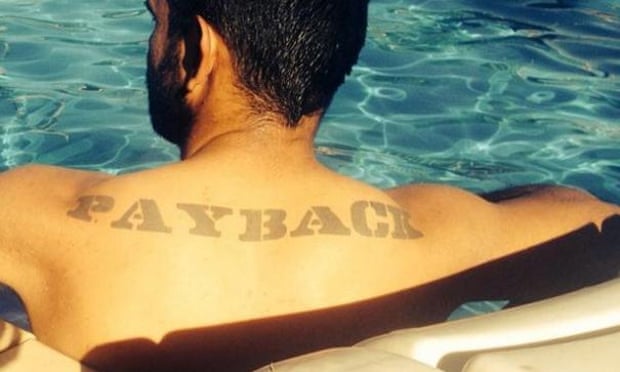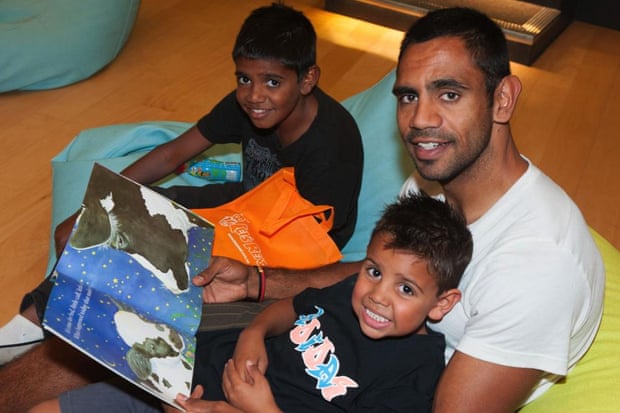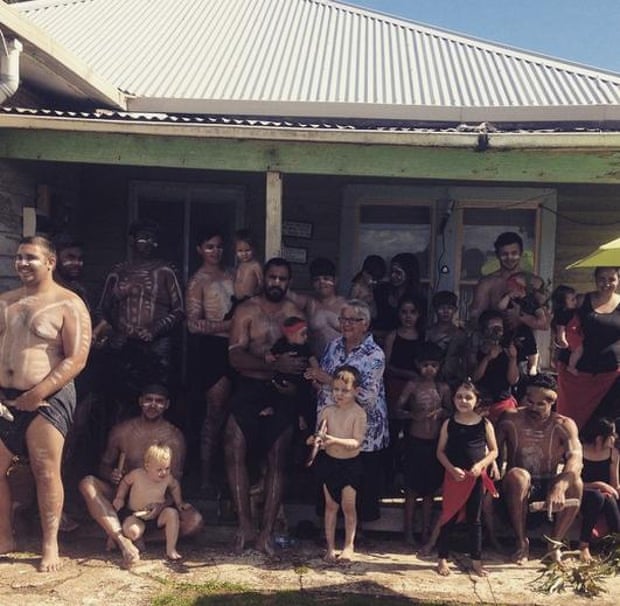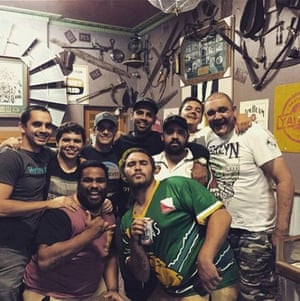Pretty good read about Nathan Lovett-Murray and his history in The Guardian today by Joe Gorman.
Nathan Lovett-Murray: ex-AFL star and family still surviving despite struggles The former Essendon player’s family has a rich Anzac history and they now find themselves fighting another war back on Gunditjmara country in Victoria 23/4/2015
Tattooed across Nathan Lovett-Murray’s shoulder blades is the word “payback”. The name of the former AFL star’s hip hop record label, it’s etched into his skin and his family history. “Payback is an Aboriginal word for tribal punishment,” he says. “It’s a word that can relate to a lot things in the Aboriginal community, we’ve been ripped off. But this is our time now.”
Between the Lovett and Murray families – Lovett on his mum’s side, Murray on his dad’s – there is military service almost unparalleled in Anzac history. His grandfather Stewart Murray fought in WWII, and whenever there’s been a war, from WWI to Afghanistan, a Lovett has served. Five of the Lovett brothers fought in both WWI and WWII. But Lovett-Murray’s is a different battle – he’s fighting for land, for country and for black empowerment. He calls it “the struggle”.
Two years after finishing his career with Essendon in the AFL, Lovett-Murray returned to Heywood in August, 2014. Heywood is on Gunditjmara country, roughly equidistant from Melbourne and Adelaide in rural western Victoria. It’s a small town. One main street, a few shops, a pub, 1,300 people and a footy club, this is Lovett-Murray’s old stomping ground. Home.
Most of Lovett-Murray’s family, and there are a lot of them here in Heywood, are involved in the Wind-mara Aboriginal Corporation and the Gunditj Mirring Traditional Owners Aboriginal Corporation. In March, when Nathan was made a life member of Essendon, he took his nan along as his date. His focus is with his family and his new job as a justice worker with Wind-mara and as a player-coach with Heywood Football Club.
Nathan Lovett-Murray with sons Nyawi (left) and Mara (right) at the Let’s Read National Early Literacy Campaign launch in Melbourne in 2013. Photograph: Progressive PR/PR Image
After surviving the 20-year-genocidal frontier wars, ongoing dispossession, marginalisation, outright discrimination, not to mention 10 years in the federal court, the Gunditjmara nation has finally been recognised as the traditional owners of the land. Lovett-Murray, 32, has returned to a community empowered by native title rights, which were determined in 2007. “We always say we look after the land and the land looks after you,” he says. “It feeds us. When I was playing for Essendon I’d always come home and it would reinvigorate and re-motivate me.”Although there is an acknowledgement of the Gunditjmara people’s traditional ownership, Lovett-Murray remains sceptical of native title. Like many Aboriginal people he sees it as a compromise in the struggle for true land rights. “I just reckon that our people should be compensated, and a treaty put in place,” he says. “The land should be given back, but with no strings attached. We should be able to do what we want with the land.”
He wants reparations, not recognition. Still, the process of decolonisation is firmly underway. Lovett-Murray’s son is learning Gunditjmara language along with the white kids at Heywood primary school, Lake Condah has been re-flooded, allowing the native wildlife to return, and the family is lobbying government to formally change the name of Mt Eccles to Bundj Bim.
It wasn’t always this way. The first place Lovett-Murray takes me to is the old Lake Condah Mission where the Gunditjmara lived until 1918. A few remnants of the old stone houses remain, and where St Mary’s church stood is a single wooden crucifix. “It was bombed,” explains Lovett-Murray, “they wanted to get the people off the mission.”
Throughout Victoria, after WW2 land was divided up and given to returned soldiers. Despite their service, neither the Lovett nor the Murray family were granted land. Lovett-Murray’s great-uncle Herbert sent this letter to the Secretary of the Aborigines Protection Board in 1945:
Dear Sir,
I am writing to you to see if you could give me any information regarding the cutting up of Lake Condah Mission Station into blocks for Aboriginal Servicemen of this war.
If same was being done I would like to make application for a block.
Awaiting your early reply
I remain yours Truly
Y 5180 Pte H S Lovett
2nd Sub Dept
1st B & D
Tocumwal
NSW
He didn’t even get a response. The Gunditjmara were forced to watch as their mission was carved up and given to white soldiers. On the other side of the family, Stewart Murray sent three similar letters, all of which were ignored. Later, he fought for years with RSL president Bruce Ruxton to have Aboriginal servicemen march together instead of in their battalions. Lovett-Murray’s dad, Gary Murray, says they had a “love hate relationship”. Good enough to take a bullet for empire, but not to receive the same wages or benefits as their fellow soldiers, in black Australia Anzac became yet another site of institutionalised racism. It remains a shameful betrayal, a historical injustice with legacies that are still being felt.
Lovett-Murray’s nan, Laura Bell, says her dad, Frederick, didn’t talk much about fighting in the wars. He didn’t talk much at all, really. Her lasting impression is watching him return home armed with Violet Crumble, black and white pudding and Minties for the kids. “I always remember his kitbag on his back,” she says. “I don’t have a photo of him in uniform, but I remember mum looking after his clothes, the shirts and the trousers. You could cut butter with the creases she put in his trousers.”
It’s still unknown why exactly Frederick and his five brothers decided to enlist. Lovett-Murray believes they wanted to gain respect for Aboriginal people for when they returned; his mum, Denise, speculates that a lack of steady work at the time led them to sign up and that they may have fought to stop more Europeans coming to Australia. Laura, however, is adamant that they just wanted to serve their country. No matter the reason, what makes the Lovett brothers’ service all the more striking is that they willingly fought alongside the descendants of the settlers who massacred their ancestors in the Eumaralla frontier wars just a few decades prior. The debt has never been repaid.
Lovett-Murray and family outside his nan’s house in Heywood. Photo taken with his permission from Instagram. Photograph: Nathan Lovett-Murray
Tuesday and Thursday night in Heywood is footy training; Wednesday is basketball with Lovett-Murray’s all-Koori Lake Condah Wanderers. At Heywood Lions Lovett-Murray is assistant to the head coach, Jason Saunders, an uncle with a considerable Anzac heritage of his own. Jason’s great-uncle was Captain Reg Saunders, the first Aboriginal man to command a rifle company. He didn’t get land in the soldier settlement scheme either.
Lovett-Murray is rangy, rough and ready, while Saunders is short, lean and highly organised. His nan calls Saunders “Tinkerbell”, while Lovett-Murray is Nat-rat, or Uncle Nat-rat to the kids. In the dressing sheds, Saunders reads clear, concise instructions off a sheet of paper, highlighting two negatives and two positives from the previous game. Lovett-Murray, meanwhile, riffs with his team-mates about contests, asking them questions off the cuff and fielding questions in return.
As the boys go through the drills, what immediately sets Lovett-Murray apart from the rest is the hand skills. His handballs zip and pop with considerable speed, his hands whirring in perpetual motion. Watching on, the club president, Lovett-Murray’s uncle Michael Bell (he calls him “Uncle Mookeye”) tells me Heywood made the tough decision to drop back to district footy in order to remain competitive and retain the juniors.
Lovett-Murray was offered more than $2,000 a game to keep playing in Shepparton, where he won a title last season, but coming back to a lower level with Heywood means he pockets just $500 a game. “I always said I wanted to come back to Heywood and win a grand final,” he shrugs. Besides, 11 of his brothers and cousins are in this team, and this way he’s closer to home. In the hours between work and training he’s got time to pick up his son from school and have dinner at his nan’s house. Both Saunders and Bell say his presence is inspirational for the boys coming through.
The Tuesday I’m in town is Seany Mac’s 18th birthday, so after footy training there’s a party at the front bar of the Heywood Hotel. All the boys are here, and Lovett-Murray swaggers around happily in baggy tracksuit pants, baseball cap, Brotherboy T-shirt and that cheeky, impetuous grin. His uncle Darren Bell, the giant, loveable wharfie who taught him how to play physical footy, is here too. In the cold, wet winters the footy in these parts is rough, and they call Darren “Bush-rat” for his uncompromising style. That’s where Lovett-Murray, who stuck close to “Bush-rat” as a kid, got the nickname “Nat-rat”. I’m told he’s the only one to ever pin Darren down in a fight.
Uncle Michael reckons Lovett-Murray “never left the community”, and it’s here at the pub where this is most evident. Once last drinks are called, everyone is invited back to his place, where the party continues. His kitchen is decorated with old trophies and a faded picture of him as a 15-year-old the Heywood Hustlers, the basketball team that became national champions in 1988. “We beat all those private school kids,” he says. The living room is full of photos of his three young kids, in the hall there are framed photos of his great grandfather Sir Doug Nichols, a former footy great and governor of South Australia. “You don’t know how much inspiration this gives me,” he says as he shows me around.
Inside the Heywood Hotel. Photo taken with Nathan Lovett-Murray’s permission from Instagram. Photograph: Nathan Lovett-Murray
As the night turns into the early hours of the morning, his brother Tyson talks about researching the family history and the eel fishing of the Gunditjmara, the world’s oldest known fishing technique. Another brother Jason tells me about their dance troupe the Fighting Gunditjmara. “We’re bringing back culture that past generations lost,” says Jason.
On the verandah, one of the young guys Lovett-Murray is working with in his role at Wind-mara dances with him playfully, pulling one of Lovett-Murray’s Essendon tops tight over his barrel chest and gut. He’s been in trouble with the gangs around these parts, but with the support of Lovett-Murray he’s finishing off his community work and getting back on track. As Lovett-Murray removes his own shirt, you can see the dark wound on the underside of his right bicep, where in 2013 he was stabbed in his Melbourne home. Whatever the challenges, Lovett-Murray has never wanted to remove himself from his people and his community.
“It’s the struggle,” he says. “You feel it when you meet other blackfellas, you always nod at another Aboriginal person in the street even if you don’t know them. I never said I’m Australian. That flag, all it says to me is the massacres and murders. People say they fought for the flag, I’ve always understood it to be fighting for your mates, not for a flag.”
In early March, Lovett-Murray got a call from Meriki Onus from the Warriors of the Aboriginal Resistance. WAR have been busy organising protests against the Western Australian government’s plan to forcibly close down remote Indigenous communities. The prime minister, Tony Abbott, flippantly called the Aboriginal spiritual connection to land “lifestyle choices”. Onus wanted Lovett-Murray to lend his name to the cause.
He readily obliged, and on 18 March tweeted a photo of himself with a placard that read “stop the forced closure of Aboriginal communities”, with the hashtag #SOSBLAKAUSTRALIA. He sees the activism as “spreading the truth”, and knows having a profile helps raise awareness of the issues. Next, he messaged his Aboriginal mates at AFL clubs, asking them to do the same. Soon protest pictures of AFL players, past and present, were shared on social media. “The AFL is the perfect example of pan-Aboriginality,” says Lovett-Murray, “the Aboriginal boys will always embrace after the game and see how each other are going.”
The protest pointed to two key themes that inform Lovett-Murray’s politics: land and solidarity. He sees the forced closures of Aboriginal communities in Western Australia as yet another land grab. “I felt the same way about the [Northern Territory] intervention, it’s the same story,” he says. “Victoria might be next, they’re going to want our land back. You’ve got to support each other. The system is set up to keep us divided and fighting amongst each other over funding. They call it lateral violence – past trauma passed down through generations and people fight amongst each other.”
The Gunditjmara people were finally defeated in the 20-year frontier wars after the settlers employed Aboriginal people from Queensland to track them into the rocky areas where the settlers couldn’t reach. Lovett-Murray calls it “black yabbie syndrome”, an adaptation of the tall poppy syndrome. “Two farmers have a bucket of yabbies each, one has a lid and the other one doesn’t. The farmer with the lid says to the other one, ‘you better get a lid for those yabbies’. The one without says, ‘it’s OK, they’re all black yabbies in there, if one tries to crawl out the other ones will pull him back down’.”
— Nathan Lovett-Murray (@NATRAT42)
March 18, 2015
#SOSBLAKAUSTRALIA #Protest #Rally #Australia #Melbourne pic.twitter.com/2XcVMnJZu1Lovett-Murray wasn’t always political. His mum and dad were both involved in setting up Koori organisations, but as a kid he reckons he was too involved in sport. The racism at Heywood primary school was terrible, so he bashed the kids who called him names, and by high school it had stopped. “I think my reputation came with me,” he laughs. At 14, he read Bruce Elder’s Blood on the Wattle: Massacres and Maltreatment of Aboriginal Australians Since 1788. “I knew about our own massacre sites,” he says, “but that showed me there were similar stories everywhere.”
The Guditjmara people were decimated by the white invaders. His mum Denise shows me around the Convincing Grounds on the beach at nearby Portland, where an entire clan group were wiped out by a British whaling family. As the clan descended to prepare a beached whale for food, they were shot one by one: men, women and children. Only two survived. “There was always an understanding [of politics],” says Denise of her son. “I remember as an eight-year-old, Nathan was watching TV and there was an Aboriginal man protesting. He said, ‘look, that’s our family’.”
But it was footy, and in particular Essendon Football Club, that gave Lovett-Murray the inspiration to learn more. At Essendon the annual Anzac Day match made him enquire further about his family’s service, and brought him under the influence of Kevin Sheedy, Dean Rioli and Michael Long. Sheedy encouraged him to get out to remote Aboriginal communities, Rioli he describes as a “big brother”, while Long was a “mentor”. In Melbourne he sought knowledge from his dad, Robbie Thorpe, Geoff Clark and Gary Foley, all veterans of the Black Power movement.
Lovett-Murray is carried off the ground by his Essendon team-mates after he retired from the game in August 2013. Photograph: Joe Castro/AAPIMAGE
His politics took a radical turn in 2006-2007. First, he took a trip to Mutitjulu, a remote Aboriginal community near Uluru where he stayed with elder Bob Randall. Two weeks later he travelled to South Africa, visiting the slums and ghettoes. “The conditions are just as bad here, if not worse,” he says. “We’re treated like second class citizens. It opened my mind up to the bigger picture.”
Denise tells me she noticed the change in her son when he came home, and it was reinforced by the Close the Gap campaign in 2007. During the height of the campaign he witnessed eight funerals – friends and families in their 20s and up – in just two months. “There’s a health crisis here,” he explains. “There was a genocide here, it just wasn’t as big as others. There’s many traumatic experiences from massacres to stolen generations to settlement schemes.”
When Lovett-Murray speaks about politics, it’s tinged with a black class consciousness. “They don’t like blackfellas making money” is one familiar refrain; another is “the rich are getting richer while the poor are getting poorer”. But everything, no matter what the subject, is connected back to land. Land is spiritual wealth. As we walk around Lake Condah, he points out old eel and fish traps and places where he would camp as a kid. The sophisticated aquaculture of the Gunditjmara is internationally recognised and disproves the myth that Aboriginal people were nomadic. Being back here, learning and being close to the land gives him what he calls “cultural empowerment”.
But he wants more. Having recognition of the land is one thing, but he’s looking for ways to create wealth in the community in order to become less reliant on government. Frustrated that there is no treaty, and that native title doesn’t provide communities with an economic base for self-determination, he wants to see black-owned and black-controlled businesses.
Payback Records is a starting point. Since 2007 he says he’s invested around $500,000 of money earned through his football career into promoting Indigenous rappers. “Aboriginals are not business minded,” he says. “Materialism is not part of our culture. But you’ve got to have money to make money. There’s a lot of talent, it’s just about the environment. I wanted to create an environment where we’d release the music, promote it and publicise it, and take Indigenous culture to the world through hip hop.”
There are some good young artists coming through – Lovett-Murray has high hopes for his cousin Philly from Mildura who releases his next single in May – but there’s a long way to go. Apart from Urthboy at Elefant Tracks, there hasn’t been much interest in Payback from the white Australian hip hop labels. “I’m not going to dwell on it,” he says. “You just move forward. 50 Cent, KRS One, Afrika Bambaattaa, Snoop Dogg, Akon, they’ve all reached out. KRS One has been the most supportive, and he says we need to go overseas where there is a bigger market.”
Ultimately, his dream is to put on a concert at the MCG to raise awareness of the Aboriginal health crisis. For the moment, the focus is with his community. He won’t be marching on Anzac Day, but he’ll be there on 1 May for the national protest against the forced closures of communities. They say there’s an Anzac spirit, but Lovett-Murray’s personal drive has been forged out of the injustices of Anzac. “My kids have inherited the stresses of my father and my grandfather,” says his dad.
Sir Doug Nichols once told Stewart Murray, “we have to use the past to build the future”, and that ethos seems to have been passed down to Nichols’s great-grandson. Lovett-Murray’s war for better health and educational outcomes, for self determination and for land as a means of economic and spiritual survival continues back in Heywood.
“We were at war and our people lost,” he says. “My belief is they wanted to wipe out Aboriginal culture and the Aboriginal race. They don’t realise how strong we are. We’re still surviving.”




